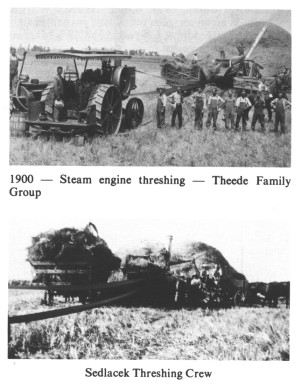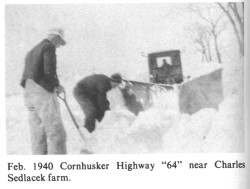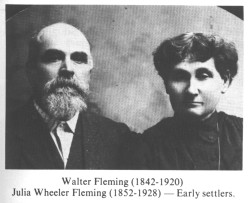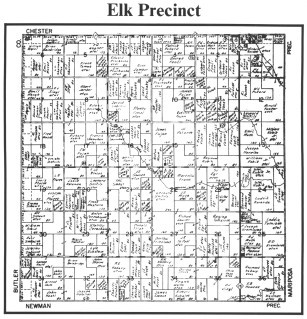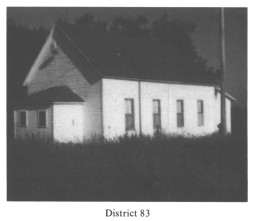 |
DOUGLAS PRECINCT |
ELK PRECINCTElk Precinct is situated in Township 15 range 5. It is bounded on the north by Chester, on the east by Mariposa, on the south by Newman and on the west by Butler county. The Burlington Railroad cuts through the northeast to the northwest, ending in Prague. The first Czech settler, Peter Kastl, came to Elk Township in June of 1867. He settled next to a stream several miles southwest of Plasi. In 1868 he was followed by Michael Petrzelka, John Vanous, James Reap and Joseph Simanek. In 1871, Martin Vanek, Vencl Kaspar and George Ebling came. The first country school in the county was known as "Vanek School" and later was called District #84. It was founded in 1878. As in all early schools at this time, books were kept in Czech. It cost $20.80 to build the school. The lumber cost $720.63. The teacher received $29.00 a month for 8 months. This school was in existence till 1968 when, by vote of the patrons, the school joined District #104. Records of District #83 go back to 1898 and the boundaries are the same now as they were then. The original building was dismantled in 1905 and a new one built at that time. This school is still in session because of a continuing enrollment. District #19's records start in 1884; and in 1963 Districts 106 and 94 voted to join #19. The building of the original #19 was sold to a former pupil, Josephine (Havlovic) Koranda, who moved the school intact to a farm nearby that she owned. It is being kept as a keepsake. The three districts moved the newer, more modern school from District 106 and remodeled it to conform to much newer teaching methods, As in the other districts in this township, the students were mostly of Czech descent. The teachers in the early years were mostly male and not of Czech descent.
page 75 In section 15-5-5 the cemetery was organized at the same time as the Catholic church. It was consecrated, on July 1, 1880. Several settlers' graves, at this time, were moved from a field owned by Frank Jambor to the present site. In 1970 the Cemetery Board added more burial ground and erected a Calvary Group. On June 8, 1874, land was purchased for a church and burial place. SW¼ of SW¼ section 3 township 15 range 5 was the site. The organization for the development of this site was called "Cesky Bratersky Evangelisky Congregation." The Church was moved to the town of Prague. The Cemetery is still used for burials. A private burial ground is in section 4. It has only two or three graves and is maintained by the descendants of the Vavak family. The Precinct officers for 1983-87 are: Charles R. Prochaska, Chairman; Larry Woita, Clerk; and Leonard L. Chapels, Treasurer. Submitted by Charlotte Sousek PLASIJosephine Mach Sousek of North Bend lived in the Plasi community as a child. She recalls and tells that on Christmas Eve they attended Mass at Plasi Church. They usually walked and so did many of the neighbors along the way. Before they arrived at church there was a large group of them. She mentioned that there were barns on the church property then. Before Mass, some would tie the horses only to a post, while others put them into the barns. Many times they walked or rode carriages to church. After church services, everyone would gather to visit. There was also a Post Office on the church property, where everyone picked up their mail. It was brought once a week from Prague to Plasi by Mr. Kocarnik. Catechism was every Saturday during the summer months. Many times the children would cut through the meadows to make the miles shorter, rather than going on the roads. SS. CYRIL AND METHODIUS |
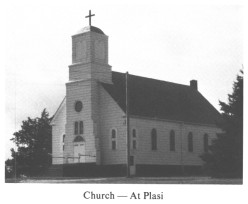 |
| Church -- At Plasi |
During this time Plzen (Plasi) was being considered for a monastery. Due to a misunderstanding and influence of some freethinkers the project fell through.
In 1890, the parish consisted of almost 300 members covering an area including Wahoo, Touhy, Weston, Prague and Bruno.
Lightning damaged the steeple in 1891 and it was removed and a new taller steeple with a bell and 24 feet were added to the church.
The women of the parish organized the Rosary Society with the purpose of cleaning the church and the upkeep of linen vestments and sanctuary equipment.
On April 14, 1901, by an unknown cause the first church burned. Under the leadership of Father Vlcek and a Building Board, a larger church was planned and built. It was completed by Sept. 1, 1901. In 1927 the Parish celebrated its 50th Jubilee. The pastors during this time received only a small stipend for their services. They were often given a cow, some chickens and sheep, and possibly a hog for butchering. In addition parishioners brought them some food. Open air dances were held along with the annual (Pout) Sts. day dinner, with neighborhood bands playing Polkas and Waltzes for entertainment.
August 4, 1934, the second church was destroyed by fire. It was 114° and it was believed that a lit candle bent in the heat and lit the papers which set the church afire.
Immediately a building board was chosen and under the direction of Reverend Victor Mlejnek a new church was built. It was dedicated on October 24, 1935. During these hard times Father Pastorak initiated card parties, bingo, Czech plays, and a softball team for entertainment.
The church has been maintained as a Mission to St. John's Prague since the retirement of Father Pastorak.
Many improvements and changes have been accomplished through the years with generous donations and gifts of individual parishioners.
Religious education programs are taught by volunteers under the direction of the Pastor.
Pastors who have served in this church are as follows: Frantisek Sulak, Frantisek Bobal, Vaclav Kocarnik, William Coka, Jordan Stutz, Frantisek Hovora, Jan Vlcek, Victor Mlejnek, Alois Gryc, Frantisek Kopecky, Vaclav Pokorny, Josef Blacha, John B. Pastorak, Ray Roh, John J. McCabe, and John Glaves. Submitted by Charlotte Sousek
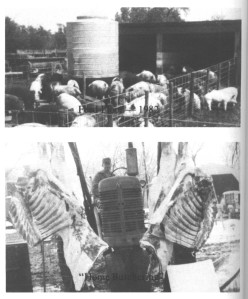 |
MUSIC TEACHER
Mrs. Ed (Lucille) Kremlacek started teaching in 1952 and is still teaching piano and accordion students in her home. She has had as many as 40 pupils taking individual lessons. Students have entertained at local events and participated in Mid America Music Contests, winning many superior ratings and trophies. She has had several recitals.
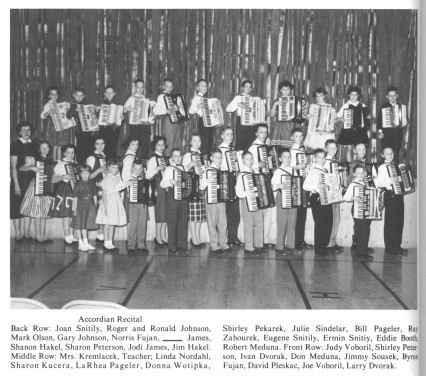 | |
| Accordian Recital Back Row: Joan Snitily, Roger and Ronald Johnson, Mark Olson, Gary Johnson, Norris Fujan, ___ James, Shanon Hakel, Sharon Peterson, Jodi James, Jim Hakel. Middle Row: Mrs. Kremlacek, Teacher; Linda Nordahl, Sharon Kucera, LaRhea Pageler, Donna Wotipka, |
Shirley Pekarek, Julie Sindelar, Bill Pageler, Ray Zahourek, Eugene Snitily, Ermin Snitiy, Eddie Booth, Robert Meduna. Front Row: Judy Voboril, Shirley Peter- son, Ivan Dvorak, Don Meduna, Jimmy Sousek, Byron Fujan, David Pleskac, Joe Voboril, Larry Dvorak. |
page 76 |
| Back | Contents | Next |
The Saunders County NEGenWeb Project

